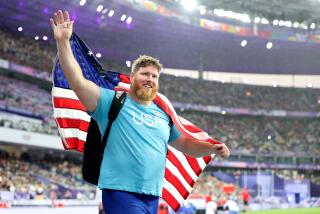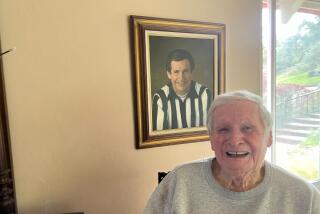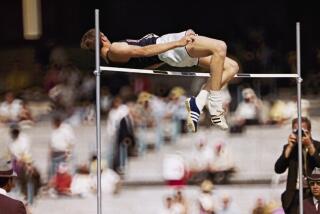He bent over backward to raise bar for high jumpers
Dick Fosbury never intended to turn high jumping on its head. Leaving an indelible mark on the sport of track and field was not his mission.
âI certainly didnât set out to change the world,â says the accidental revolutionary, who in the 1960s not only introduced a then-radical high-jumping technique that would change the event forever but also coined a catchy name for it: the Fosbury Flop. âI was just trying to figure out a way to jump a little higher for my own self.â
For the record:
12:00 a.m. March 7, 2007 For The Record
Los Angeles Times Wednesday March 07, 2007 Home Edition Main News Part A Page 2 National Desk 0 inches; 26 words Type of Material: Correction
Olympics: In Mondayâs Sports section, an article on former high jumper Dick Fosbury referred to then-U.S. Olympic coach Pat Jordan. The coachâs name is Payton Jordan.
But after Fosbury won Olympic gold at the 1968 Mexico City Games by utilizing his unorthodox new technique -- turning his back to the bar before propelling himself over rather than stretching out face down in the time-honored âstraddleâ style still widely in vogue at the time -- high jumping was never the same.
Little boys started jumping backward over couches in living rooms all over the United States, it was said, and the straddle era was soon in decline.
Today, virtually all high jumpers utilize the Fosbury Flop. No one using the straddle technique has held the world record since May 1980.
âOnce I came home from the Olympic Games, I discovered that all these kids had seen me jump on television,â says Fosbury, a 21-year-old Oregon State student when he won his gold medal. âThey were the ones that really revolutionized the event. But I really feel honored and humbled that I was able to make a contribution to the sport that I think has helped improve the performances.â
Fosbury, who turns 60 on Tuesday, runs an engineering firm these days and lives with his girlfriend, Robin Tomasi, on a 20-acre ranch outside Bellevue, Idaho.
A snowboarder and mountain-bike enthusiast when he can find the time, Fosbury was a high school student in Medford, Ore., when he started experimenting with the high-jumping technique that would come to define him.
âIt was not a conscious or planned thing at all,â he says. âIt was simply a reaction by my body to get over the bar. I converted an old style -- the scissors style -- into something that was much more efficient.
âWhen youâre jumping with the scissors technique, youâre going over the bar in a sitting position. I converted it to just laying out flat on my back.â
His coaches at Oregon State, which was the only school to offer him a scholarship, tried to get him to convert to the straddle style, but Fosbury was unable to master the more conventional technique, so he continued flopping.
âItâs a natural style,â he says. âThe advantage from a physics standpoint is, it allows the jumper to run at the bar with more speed and, with the arch in your back, you could actually clear the bar and keep your center of gravity at or below the bar, so it was much more efficient ... and it was a simpler movement.â
Taking advantage of the raised, softer landing areas that were becoming standard, Fosbury cleared 6 feet 10 inches as a college sophomore and as a junior cleared 7 feet more consistently than any other high jumper in the nation.
Along the way, he was asked what he called his technique.
âWith my engineering background, the first time I was asked how I described the jump, I said, âWell, itâs a back layout,â and the journalists went, âUh-huh,â â Fosbury says, laughing.
âSo the next time I was interviewed I recalled a photo in my hometown newspaper in Medford, and the caption was, âFosbury flops over bar,â and so I told the journalists, âBack home they call it the Fosbury Flop,â and they just loved it. The alliteration was part of it, but I also liked the contradiction of being successful with a style whose name has a negative connotation: a flop.â
The Fosbury Flop might have been forever forgotten, however, if its namesake hadnât made it to Mexico City -- and Fosbury very nearly didnât. In the face of a nonstop series of competitions in the year before the Olympics, he says, he flunked out of school, was put on academic probation and lost his draft deferment.
The U.S. government summoned him for a physical in the spring of 1968, he says, and âI would have been going to Vietnam,â but because of a congenital spinal injury Fosbury was ruled unfit for military duty, clearing his path to the Olympics.
Still, even after he enthralled a capacity crowd in Mexico City and won his gold medal with a leap of 7-4 1/4 , his style was not immediately embraced.
Doctors cautioned that the new technique involved unsafe landings and could lead to serious injuries, and even U.S. Olympic coach Pat Jordan told reporters, âKids imitate champions. If they try to imitate Fosbury, he will wipe out an entire generation of high jumpers because they will all have broken necks.â
The fears, of course, proved unfounded, and Fosbury failed to reach the 1972 Olympics not because of an injury but because of a lack of preparation. In order to get back into engineering school at Oregon State, he says, he had to agree to stop competing and he had jumped infrequently in the three years before the â72 U.S. Olympic trials. Another flopper, 18-year-old Dwight Stones, succeeded Fosbury as the top U.S. hopeful, winning a bronze medal at Munich.
Fosbury may have been finished, but the Flop lived on.
âThis style was going to become popular,â he says. âI was simply blessed to be the first one to use it, so I got the credit and I got to name it.â
More to Read
Go beyond the scoreboard
Get the latest on L.A.'s teams in the daily Sports Report newsletter.
You may occasionally receive promotional content from the Los Angeles Times.






